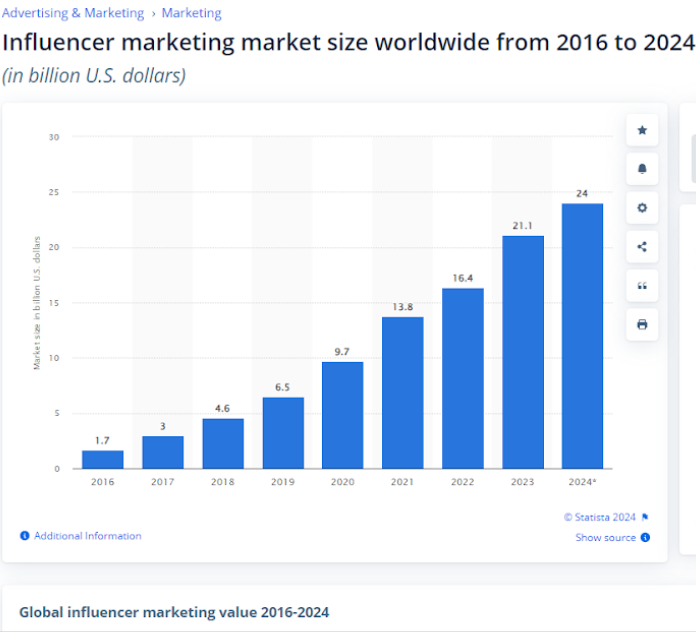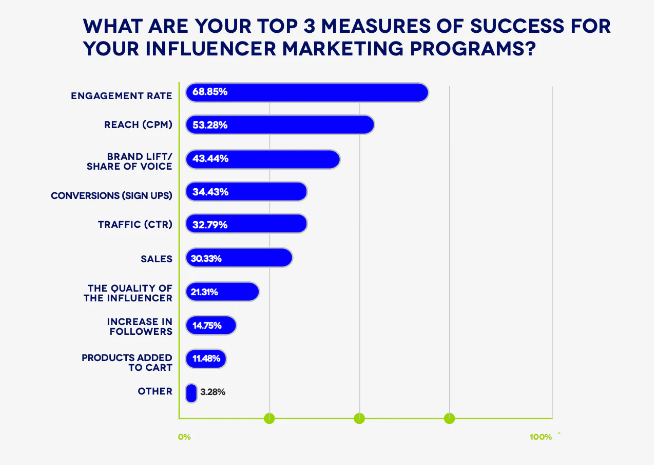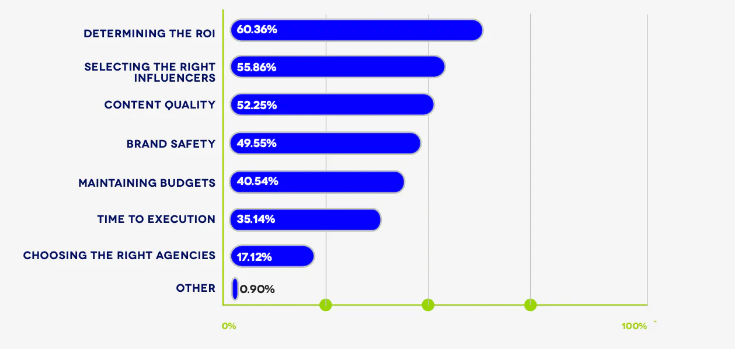Table of Contents
The effectiveness of any influencer marketing campaign rests on the quality and reach of your influencers. Influencer mapping is a vital strategy to measure how well connected your chosen influencers are. For any brand seriously considering influencer marketing, influencer mapping is necessary and valuable.
Influencer mapping is the best way to gauge how persuasive an influencer’s impact is. In short, it can help you decide if they are a good match for your company and its ambitions.
Having this kind of data is important to any business using influencer marketing. Decisions such as how to compensate influencers, or how to launch or promote products through them all rest on quantifying what an influencer can bring to the table.
Let’s look at influencer mapping in more detail and drill down into how it affects campaign performance.
Free to use image sourced from Pexels
What is influencer mapping?
As you can see from the chart below, influencer marketing is a rapidly growing marketing method. But what exactly is it?
Essentially, influencer mapping is a tool that allows you to find, assess, and choose influencers who match your requirements for achieving your campaign objectives.
One of the main things you will be looking for is influencers who have a strong, personal connection with their followers and are effective content creators whose output is compatible with your brand, products, services, and values.
Image sourced from statista.com
The benefits of influencer mapping is that it can help you find and evaluate influencers who are likely to have the most impact on your target customers, and who are capable of influencing the consumer base of your particular business sector. For example, you might want to use TikTok for your brand, to reach a younger audience; influencer mapping can help you choose the Tiktoker with the impact you are looking for.
Detailed influencer mapping is a way of ranking influencers and finding out who the key opinion leaders (KOLs) really are. In other words, through influencer mapping, you can find out whose voice, opinions, and posts really count in targeting customers in your industry.
This can reveal surprising results; the loudest voice doesn’t necessarily have the biggest impact. Hard data can help you separate reputation from reality when it comes to finding a person to be an effective brand ambassador.
Why is influencer mapping important?
First of all we need to understand why influencer marketing itself is important. Surprisingly, in terms of influencer marketing trends, most marketers don’t judge the ROI (return on investment) of influencer marketing as being about sales. In fact, according to a report by Linqia, just 30% of marketers consider sales a measure of influencer marketing campaign success.
Engagement, brand awareness, and image are really where influencer marketing comes into its own. Influencer mapping is important, as it allows businesses to compare different influencers based on real data. This is vital, as often an influencer can give an impression of reach and impact, but this may not be backed up by numbers.
If you are going to allocate valuable marketing spend on influencers, you need to verify not only the authenticity of influencers, but also their likely impact on your marketing goals.
Free to use image sourced from Pexels
Let’s look at the key advantages of influencer mapping.
- Influencer mapping ensures that your selection of influencers exposes your brand to the right followers, boosting your visibility and impact.
- Influencer mapping can reveal which territories and geographical locations your influencer’s followers are located in. This helps you select and tailor content and products to regions.
- Influencer mapping can help you spot and stay ahead of fashions and trends. This is possible by tracking what influencers active in your sector are posting and talking about.
- Influencer mapping can enable you to know who your chosen influencers are as people thoroughly, understand what motivates and interests them, and with this knowledge, build long-term relationships with them.
- Influencer mapping can give you valuable consumer insights. Influencers exert their power via social media algorithms that draw followers to them and build their fanbase. Noting how an influencer’s followers behave and how they respond to content can reveal important insights about your target audience.
Image sourced from shopify.com
Making influencer mapping work for campaign performance
To make influencer mapping work for your business, let’s look at some key considerations and actions.
1. Define goals and audience
Knowing exactly what you want your influencer campaign to achieve is the foundation of a successful campaign. Carefully consider your objectives and have a clear roadmap for achieving them.
Do you want to increase your reach in new geographical territories? Looking to rebrand or shift perception of your products and services? Wanting to raise brand awareness and drive sales? Or do you want a specific social media outcome such as maximizing your brands’ engagement on Threads?
Decide who your target audience is in relation to these objectives. Think about demographics, psychology, and consumer behavior, and consider the best way to reach them, in terms of influencers and the style of your influencer campaign.
2. Research influencers thoroughly
As you can see from the image below, one of the top challenges for influencer marketing is selecting the right influencer in the first place. These results from Linqia demonstrate the importance of thoroughly researching influencers and choosing someone who will really work well for your brand.
It’s a good idea to track the potential influencer over a period of time. How do they rank in search engine results? How many followers do they have? What demographics do their followers fall into? Where geographically do the majority of their followers reside? Do these findings fit with the kind of customer you want to target?
Image sourced from shopify.com
3. Identify the best social media platforms
Having established that a particular influencer is a good fit for your business, it’s important to then make sure that the social media platforms they are posting on are also a good fit.
This is where it’s important to think about demographics. Some age groups and geographic regions favor particular platforms such as TikTok or YouTube over Facebook or Instagram.
It’s vital to determine which platforms resonate with your customer base and potential new customers. Armed with this knowledge, you can not only choose the right influencer, but you can also make sure they are active on the best platforms for your business goals.
4. Get advice from industry experts
Experience is worth its weight in gold; if you have industry colleagues and peers who have successfully used influencers, make sure you learn all you can from them. Ask them to tell you about the pros and cons of working with influencers, where they found the influencers they formed a partnership with, and how successful the resulting campaign was.
5. Look at influencer databases
Influencer databases can be a useful resource to find influencers linked to particular business areas or interests. You can also search based on engagement rates, audience size, and influence. Databases also provide access to analytics and hard numbers to help inform your decision making.
6. Analyze and adjust based on results
Influencer mapping doesn’t end once a campaign is launched. It’s important to monitor and log online conversations about your brand and interactions around your brand between an influencer and their followers.
Gather insights to help steer future campaigns; look for areas to improve and successful strategies to replicate.
Remember to give feedback to the influencer in a positive and polite way, but be honest in asking for any changes you would like made mid-campaign.
7. Make sure your business is ready to capitalize on a successful campaign.
If all goes well, your influencer campaign will raise your brand profile and impact, as well as boost sales and traffic to your website. Make sure that your business is prepared for what may be a sudden influx of interest and contact driven by an influencer marketing campaign.
Ensure you have the right infrastructure, staff, and technology to meet demand. For example, make sure that your call center is fit for purpose; perhaps a TCPA compliant dialer could help effectively process leads and capitalize on influencer-generated interest.
Conclusion
Influencer mapping is the smart way to approach influencer marketing campaigns. It’s easy to think that simply being talked about online is enough to boost brand awareness. Powerful influencers seems to be all you need!
However, effective influencer mapping is the only surefire way to align your influencer and your brand. This will ensure that they can work together for mutual benefit.
Influencer mapping is a way of testing the waters before you consider trusting an influencer with your brand image.
When done thoroughly, influencer marketing is a fantastic way to reach new audiences, tell your brand’s story, and engage with customers.




























